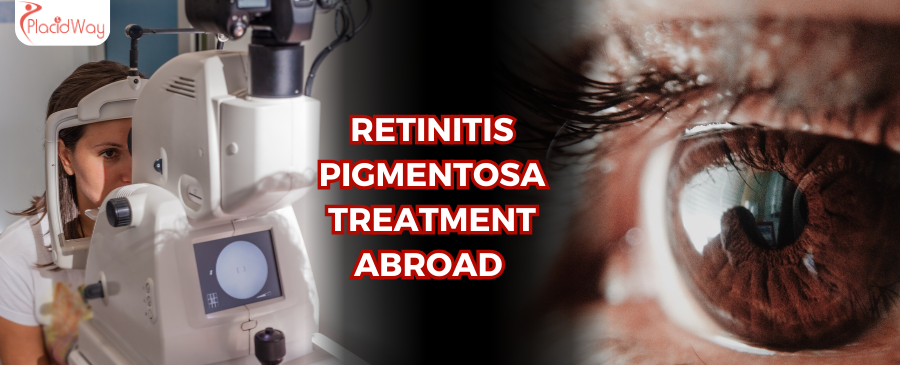
Unlocking Hope: Advanced Retinitis Pigmentosa Treatments Worldwide
Living with Retinitis Pigmentosa (RP) can be a challenging journey. This inherited eye disease slowly but progressively causes vision loss, often beginning with difficulty seeing in low light and gradually narrowing the field of vision. If you or a loved one are experiencing the early signs of RP, or have been living with its effects, you understand the profound impact it has on daily life. The good news is that advancements in medical science are continuously bringing new hope, with innovative Retinitis Pigmentosa treatments emerging globally.
Retinitis Pigmentosa refers to a group of genetic disorders that affect the retina, the light-sensitive tissue at the back of the eye. Over time, the photoreceptor cells (rods and cones) in the retina deteriorate, leading to a decline in vision. While historically there were limited options beyond managing symptoms, today's landscape includes groundbreaking therapies like gene therapy, stem cell treatments, and retinal implants that aim to slow progression or even restore some vision.
For many, accessing these cutting-edge Retinitis Pigmentosa treatments means looking beyond their local healthcare systems. Medical tourism has become a vital pathway, connecting patients with specialized clinics and leading experts around the world. Whether you're searching for "RP gene therapy options," "stem cell treatment for RP abroad," or "new treatments for Retinitis Pigmentosa," this guide will explore the possibilities, help you understand the condition, and navigate the journey towards restoring vision hope.
What are the common symptoms of Retinitis Pigmentosa?
Recognizing the early signs of RP is crucial for timely intervention. While the progression varies among individuals, common symptoms often appear in childhood or early adulthood and worsen over time:
- Night Blindness (Nyctalopia): This is often the earliest and most common symptom. Individuals find it increasingly difficult to see in dim light or adapt to darkness, making activities like driving at dusk or navigating dark rooms challenging. Many people searching for "early signs of RP" or "why can't I see in the dark" are experiencing this.
- Peripheral Vision Loss (Tunnel Vision): As the disease progresses, rod cells (responsible for peripheral and night vision) are affected first. This leads to a gradual narrowing of the visual field, often described as "tunnel vision," where only the central vision remains intact. Patients may frequently bump into objects or struggle with spatial awareness.
- Difficulty with Glare and Light Sensitivity (Photophobia): Some individuals with RP find bright lights uncomfortable or experience prolonged glare recovery.
- Central Vision Loss: In later stages, cone cells (responsible for central vision and color perception) can also be affected, leading to difficulties with reading, recognizing faces, and distinguishing colors.
- Floaters and Flashes: While not exclusive to RP, some patients may experience floaters (specks or lines drifting in vision) or light flashes.
If you're experiencing these changes, consulting an ophthalmologist is vital for a comprehensive diagnosis and to discuss potential "RP symptoms treatment."
What causes Retinitis Pigmentosa and are there risk factors?
Understanding the "RP genetic causes" is key to understanding the condition. RP is not caused by lifestyle choices or environmental factors; it's almost always a genetic disorder. It results from mutations in one of over 100 different genes responsible for the development and function of photoreceptor cells in the retina. These genetic defects impair the retina's ability to respond to light, leading to the progressive degeneration of rods and cones.
RP can be inherited in several ways:
- Autosomal Recessive: Both parents carry a copy of the mutated gene but may not have the disease themselves. Their child has a 25% chance of inheriting two copies and developing RP. This is a common reason people search for "inherited eye disease patterns."
- Autosomal Dominant: Only one copy of the mutated gene from one parent is needed for the child to develop RP. There's a 50% chance with each child.
- X-Linked: The mutated gene is on the X chromosome. Primarily affects males, who inherit the gene from their carrier mothers. Females are typically carriers and may have milder symptoms.
- Isolated Cases: In some instances, RP appears in individuals with no known family history. This can be due to a new spontaneous genetic mutation or a recessive gene pattern that has not been expressed in previous generations.
The primary "risk factor for RP" is a family history of the condition. Genetic testing is often recommended to identify the specific gene mutation, which can be crucial for determining eligibility for certain "RP gene therapy" options.
What types of treatments are available for Retinitis Pigmentosa?
The field of "new treatments for RP" is rapidly advancing, offering a spectrum of options beyond traditional symptom management. Here are some of the most promising and sought-after therapies:
- Gene Therapy: This revolutionary approach aims to correct the underlying genetic defect. Luxturna (voretigene neparvovec) is an FDA-approved gene therapy for patients with a specific RPE65 gene mutation, which can improve vision. Research is ongoing for "RP gene therapy" targeting other genes.
- Stem Cell Therapy: Scientists are exploring the potential of stem cells to replace damaged retinal cells or protect existing ones. While still largely experimental and in clinical trials, "stem cell treatment for RP" offers hope for regenerating retinal tissue and slowing degeneration.
- Retinal Implants (Bionic Eyes): Devices like the Argus II "bionic eye" (though its manufacturer has ceased operations, others are in development) are designed for patients with advanced RP who have very little or no light perception. These implants convert images into electrical pulses that bypass damaged photoreceptors and stimulate the optic nerve, providing a form of artificial vision.
- Nutritional Supplements: High-dose Vitamin A palmitate has been shown in some studies to slow the progression of RP in certain individuals. Other supplements like omega-3 fatty acids and lutein are also being investigated. These are generally used as supportive therapies.
- Low Vision Aids: Magnifiers, telescopic lenses, and electronic devices can help optimize remaining vision and improve quality of life.
- Clinical Trials: Many patients actively seek "RP treatment clinical trials" to gain access to therapies still under investigation, including optogenetics, neuroprotection, and other innovative approaches.
The choice of treatment depends on the specific genetic mutation, the stage of the disease, and individual patient factors. Many patients explore "RP treatment options abroad" to access these advanced therapies not yet available or affordable in their home countries.
Who is eligible for Retinitis Pigmentosa treatments?
Eligibility for "RP treatment criteria" can be quite strict, particularly for cutting-edge therapies. These are not one-size-fits-all solutions. Here are general factors considered:
- Genetic Diagnosis: For gene therapies, knowing the specific gene mutation causing RP is paramount. For example, Luxturna is only for patients with a confirmed RPE65 mutation. Many individuals undergo genetic testing specifically to determine if they qualify for targeted treatments.
- Age: Some treatments have age restrictions. For instance, certain clinical trials may focus on pediatric patients, while others are for adults.
- Stage of Disease:
- Gene Therapy: Often more effective in earlier stages when there are still viable retinal cells to rescue.
- Retinal Implants: Typically for advanced RP patients with very severe vision loss (e.g., bare light perception or no light perception).
- Stem Cell Therapy: Eligibility varies widely by trial and may depend on the extent of retinal damage.
- Overall Health: Patients must be in good general health to undergo surgical procedures or specialized therapies. Co-existing medical conditions might preclude eligibility.
- Retinal Structure: The retina needs to have a certain degree of structural integrity for some therapies to be effective.
- Stable Vision: For some trials, a period of stable vision before treatment may be required to accurately assess treatment impact.
A thorough evaluation by an ophthalmologist specializing in retinal diseases, including comprehensive eye exams and genetic testing, is essential to determine if you are a candidate for specific "who can get gene therapy for RP" or other advanced treatments.
What is the recovery like after Retinitis Pigmentosa treatment?
The "RP treatment recovery time" and experience depend heavily on the type of procedure:
- Gene Therapy (e.g., Luxturna):
- Procedure: Involves a vitrectomy (removal of vitreous gel) and subretinal injection.
- Immediate Post-Op: Patients will typically experience some discomfort, redness, and blurry vision. Eye drops (antibiotics, steroids) are crucial for several weeks.
- Recovery Timeline: Visual improvement is not immediate and can take several weeks to months to become noticeable, as the gene needs time to integrate and produce the necessary proteins. Patients usually resume normal activities within a few days to a week, with restrictions on strenuous activity.
- Retinal Implant Surgery:
- Procedure: A complex surgery to implant electrodes onto or under the retina.
- Immediate Post-Op: Similar to other eye surgeries, expect some discomfort, swelling, and blurred vision. Strict adherence to eye drop regimens is essential.
- Recovery Timeline: The physical recovery from surgery takes several weeks. However, the visual rehabilitation process is much longer, often involving extensive training to learn to interpret the signals from the implant. This requires patience and commitment. Vision improvement is typically in the form of light perception and object recognition, not natural vision.
- Stem Cell Therapy (Experimental):
- Procedure: Varies greatly depending on the trial, but often involves injections into the eye.
- Recovery: Generally less invasive than implants or gene therapy, with recovery usually involving eye drops and monitoring. Visual changes may be subtle and gradual, focusing on slowing progression rather than immediate restoration.
For any "post-RP therapy care," regular follow-up appointments with the ophthalmologist are critical to monitor healing, manage complications, and assess the treatment's effectiveness.
What are the potential risks and side effects of RP treatments?
It's important for patients to be fully informed about the "RP treatment side effects" and risks associated with each therapy:
- General Surgical Risks (applicable to gene therapy, retinal implants):
- Infection: Any eye surgery carries a risk of infection (endophthalmitis), which can be severe.
- Inflammation: Post-operative inflammation is common and managed with steroids, but severe cases can lead to complications.
- Retinal Detachment: A serious complication where the retina separates from the back of the eye.
- Cataracts: Surgical procedures on the eye can accelerate cataract formation.
- Increased Intraocular Pressure: High eye pressure can occur, potentially leading to glaucoma if untreated.
- Hemorrhage: Bleeding in the eye.
- Specific Risks for Gene Therapy:
- Immune Response: The body might react to the viral vector used to deliver the gene.
- Subretinal Fluid/Macular Edema: Swelling in the central retina.
- Unintended Effects: While rare, the gene therapy could potentially affect non-target cells.
- Specific Risks for Retinal Implants:
- Implant Migration or Malfunction: The device could shift or stop working.
- Erosion: The implant material could erode through tissues.
- Conjunctival Dehiscence: The covering over the implant could open.
- Limited Visual Benefit: Some patients may not achieve the desired level of visual perception.
- Specific Risks for Stem Cell Therapy (Experimental):
- Tumor Formation: A theoretical risk with certain types of stem cells.
- Uncontrolled Cell Growth: Potential for abnormal tissue formation.
- Immune Rejection: If using donor cells.
- Lack of Efficacy: The treatment might not yield the desired results.
Discussing these potential "risks of gene therapy eye" and other treatments thoroughly with your medical team, both at home and abroad, is essential for making an informed decision.
How much does Retinitis Pigmentosa treatment cost worldwide?
The "cost of RP gene therapy" or "stem cell eye treatment cost" can be a major factor for patients, often driving the decision to explore medical tourism. Prices are highly variable and depend on the specific treatment, the country, the clinic's reputation, and what's included in the package. Below is an approximate cost comparison to give you an idea, but remember these are estimates and can change rapidly:
| Treatment Type | Approximate Cost Range (USD) | Typical Locations (Medical Tourism) |
|---|---|---|
| Gene Therapy (e.g., Luxturna) | $425,000 - $850,000 per eye (in US) / Lower in some research settings abroad | USA, Europe (select clinics), clinical trials worldwide |
| Stem Cell Therapy (Trial/Experimental) | $15,000 - $50,000+ (often clinic-specific, may not be FDA approved) | Mexico, Germany, Thailand, India, China (research-focused clinics) |
| Retinal Implant (Surgery & Device) | $100,000 - $150,000+ (device + surgery + rehabilitation) | USA, Europe (select clinics) |
| Nutritional Management & Diagnostics | $500 - $5,000 (annual, including genetic testing, specialized exams) | Worldwide |
Many patients seeking "affordable RP treatment abroad" find that the same quality of care, and sometimes even more advanced or accessible experimental treatments, are available at a fraction of the cost in countries known for medical tourism. Always ensure to get detailed quotes that include all aspects of care: consultation, procedure, hospitalization, medications, and follow-up.
Why should I consider traveling abroad for Retinitis Pigmentosa treatment?
The decision to seek "RP treatment overseas" is often driven by several compelling factors:
- Cost Savings: As seen in the cost comparison, advanced treatments can be prohibitively expensive in Western countries. Many popular medical tourism destinations offer the same or similar quality of care at significantly reduced prices, making treatment financially viable.
- Access to Advanced Therapies: Some cutting-edge treatments, especially certain types of gene or stem cell therapies, may only be available in specific countries or through clinical trials not accessible at home. Traveling abroad can open doors to these innovative options.
- Shorter Wait Times: Healthcare systems in some countries have long waiting lists for specialized procedures. Medical tourism can provide quicker access to necessary treatments.
- Specialized Expertise: Certain clinics or specialists in other countries might have unparalleled experience and success rates with specific RP treatments, attracting patients globally. Searching for "best countries for RP treatment" often highlights these centers of excellence.
- Privacy and Anonymity: For some, seeking medical care abroad offers a degree of privacy not always possible in their home communities.
- Comprehensive Packages: Many international clinics and medical tourism facilitators offer comprehensive packages that include treatment, accommodation, travel logistics, and language support, simplifying the process for patients.
For those researching "medical tourism for eye conditions," the global landscape offers a beacon of hope and practical solutions.
What should I expect when planning medical travel for RP treatment?
Embarking on "how to plan medical travel" for a complex condition like RP requires careful preparation. Here's a step-by-step guide:
- Initial Research: Identify potential clinics and specialists abroad that offer the specific RP treatment you need. Look for accredited hospitals, reputable doctors, and patient testimonials.
- Medical Records & Consultation: Gather all your relevant medical records, including diagnosis reports, genetic test results, and previous treatment history. Share these with the international clinics for an initial assessment, often done via virtual consultation.
- Treatment Plan & Quote: Once a clinic confirms eligibility, they will provide a detailed treatment plan, estimated cost, and duration of stay. Clarify what is included and excluded.
- Travel Logistics:
- Visa: Check if you need a medical visa for your chosen destination.
- Flights & Accommodation: Book flights and find suitable accommodation for your stay, considering proximity to the clinic.
- Language Support: Ensure there will be interpreters if needed.
- Local Transportation: Plan how you'll get to and from the clinic.
- Post-Treatment Care Plan: Discuss follow-up care and how it will be managed once you return home. Can your local ophthalmologist collaborate with the overseas clinic?
- Medical Tourism Facilitator: Consider using a reputable medical tourism company like PlacidWay. They specialize in "medical tourism for eye conditions" and can assist with clinic selection, travel arrangements, communication, and overall coordination, significantly reducing stress.
Preparation is key to a successful and stress-free medical journey.
How can I ensure safety and quality when seeking RP treatment abroad?
Patient safety and treatment quality are paramount when considering "safe medical tourism." Here's how to safeguard your experience:
- Accreditation: Look for clinics accredited by international bodies like Joint Commission International (JCI). This signifies adherence to global standards of patient care and safety.
- Doctor's Credentials: Verify the qualifications, experience, and specialization of the ophthalmologist who will be performing your treatment. Are they board-certified in their country? Do they have specific expertise in "RP gene therapy" or other relevant treatments?
- Technology and Facilities: Ensure the clinic uses modern equipment and has up-to-date facilities comparable to international standards.
- Patient Testimonials and Reviews: Seek out genuine patient experiences and reviews. A reputable clinic will often have case studies or allow you to connect with past patients.
- Transparency in Pricing: Demand a clear, itemized quote to avoid hidden costs.
- Communication: Ensure there's clear communication with the medical team, preferably in your native language or with reliable interpretation services.
- Emergency Protocols: Inquire about emergency procedures and what happens if complications arise.
- Medical Tourism Facilitators: Companies like PlacidWay thoroughly vet clinics and doctors, providing an added layer of assurance for "choosing international clinics" and ensuring you connect with reliable providers.
By conducting diligent research and asking the right questions, you can significantly mitigate risks and enhance the safety and quality of your RP treatment abroad.
What are patient success stories from abroad?
While individual results vary greatly depending on the specific type of RP, the stage of the disease, and the treatment received, numerous "patient success stories" highlight the transformative potential of seeking care abroad. These stories often share common threads:
- Hope Rediscovered: For many, the journey begins with a sense of hopelessness after exhausting domestic options. Discovering a clinic abroad offering a new or more affordable treatment rekindles hope.
- Improved Quality of Life: Even if full vision restoration isn't achieved, many patients report significant improvements. This could be slowing the progression of vision loss, better light perception, enhanced peripheral awareness, or the ability to navigate independently. One patient with advanced RP, after undergoing a retinal implant procedure abroad, shared how they could finally distinguish shapes and bright objects, allowing them to walk without constant assistance – a life-changing difference.
- Access to Breakthroughs: Families of children with specific genetic mutations have traveled to countries where gene therapies were in earlier stages of development or more accessible. Their testimonials often speak of stabilization of vision or even modest improvements that defy their initial prognosis.
- Personalized Care: Many international clinics pride themselves on offering highly personalized treatment plans, often with more one-on-one attention than patients might experience in overburdened healthcare systems at home. This holistic approach contributes to positive outcomes and patient satisfaction.
- Community and Support: Patients traveling for RP treatment often connect with others sharing similar experiences, forming supportive communities that share advice and encouragement, both online and sometimes in person at clinics.
These stories underscore the invaluable role medical tourism plays in providing advanced care and restoring quality of life for individuals grappling with Retinitis Pigmentosa, offering a tangible glimpse of a brighter future.
Take the Next Step with PlacidWay
Ready to explore treatment options abroad? Discover top clinics, compare prices, and get a free quote tailored to your needs with PlacidWay.
Laser Eye Surgery, LASIK Eye Surgery Abroad










Share this listing